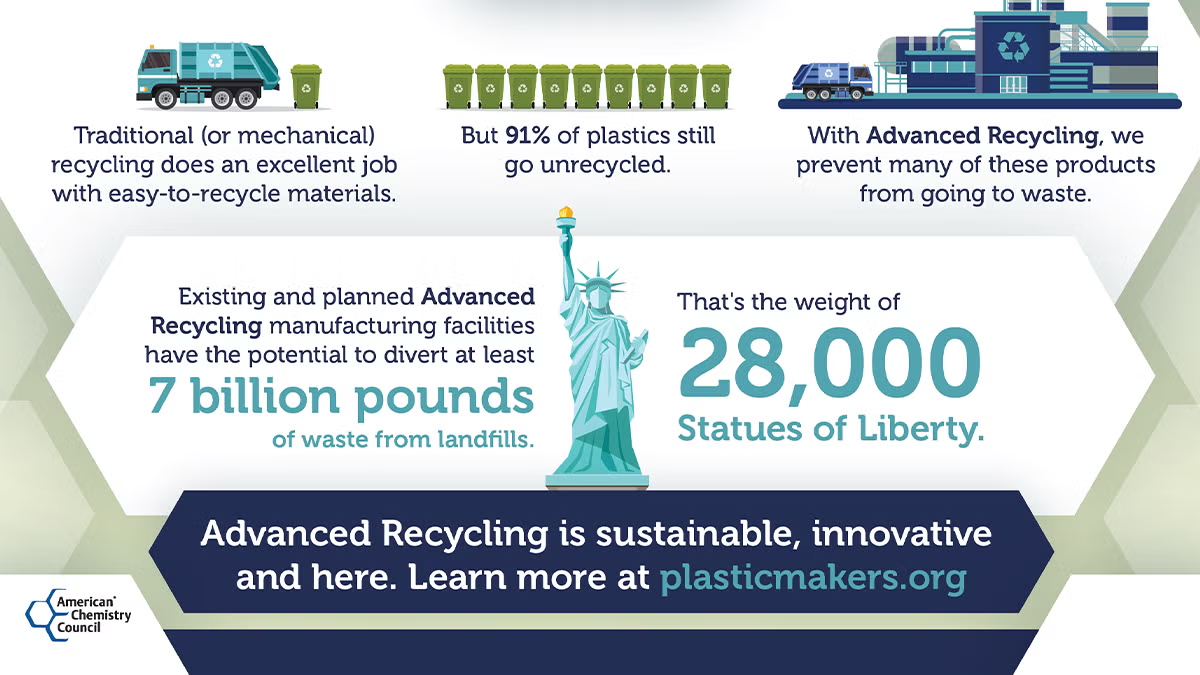You might have read that recent developments in advanced recycling are turning old problems into new possibilities. More and more, advanced recycling technologies are picking up where traditional recycling leaves off, helping to convert significantly more used plastic into new products, many of which can be recycled again and again. It’s also a field where technological developments are prompting new business models with exciting, promising outcomes for the environment.
As with anything that’s generating a lot of attention, people naturally have questions. Here are some answers.
Q. First of all, what is advanced recycling for plastics?
A. Simply put: advanced recycling harnesses the power of science to convert used plastics into new products that can be recycled again and again. By turning hard-to-recycle plastics into a reusable resource, this innovative solution is helping create a more sustainable economy and a better environment for future generations.
More specifically: these technologies break down used plastic into its original form so it can be used to make a wide range of new products. This is the way we define it at PlasticMakers.org: “Advanced plastics recycling, also called chemical recycling, refers to several different technologies that convert post-use plastics into their original building blocks, specialty polymers, and feedstocks for new plastics, chemical products, waxes, and other non-fuel products.”

Q. Why is advanced recycling important?
A. A complementary solution to traditional recycling is needed now more than ever because plastic packaging is constantly evolving in complexity to meet commercial needs, which can add challenges for traditional recycling methods. By specializing in commonly used plastics that are difficult to recycle (e.g., snack wrappers, food pouches, tubes and plastic toys), advanced recycling picks up where traditional recycling leaves off.
Today, the United States is recycling about 9% of plastics. Advanced recycling is key to ending plastic waste and keeping plastic out of the environment because it makes it possible to capture and reuse large volumes of used plastic that currently go unrecycled. As a complement to traditional recycling methods, advanced recycling is critical to achieving the goal of reusing, recycling or recovering 100% of used plastic packaging in the U.S. by 2040. Additionally, advanced recycling is capable of manufacturing high-functioning, high performing grades of plastic for food, medical and pharmaceutical uses – a tremendous breakthrough in plastics recycling.
Q. Some say advanced recycling has been around for decades; what’s different about it now?
A. Just like our cell phones have changed A LOT in the last several decades, advanced recycling technology has changed a lot too. (Anyone miss carrying around an eight-pound flip phone? Didn’t think so.) Recently, advanced recycling technologies have changed in two important ways. First, they’re being built at commercial scale. These large, multi-million dollar facilities are capable of processing millions of tons of plastics per year. Second, the technologies themselves can do a lot more. Here are three important examples that will help to revolutionize our ability to recycle many of the plastics in use today.
- Mixed Plastics. Today’s advanced recycling technologies can handle unsorted mixed plastics, which includes all sorts of packaging (think: chip bags, snack wrappers, food pouches – even toys). This makes it much easier and more efficient to re-process large volumes of discarded plastics that traditional recyclers can’t use.
- Foam Food Containers. Traditional methods to recycle polystyrene foam, commonly used for protective packaging (think high-ticket electronics) along with carryout and leftover food, met limited success. Today’s advanced recycling technologies can return polystyrene to its original form (styrene), which can be used over and over again.
- High-functioning, high-performing recycled plastics for food, medical and pharmaceuticals. Unlike most forms of traditional recycling, advanced recycling enables manufacturers to generate high performing plastics for food, medical and pharmaceutical uses. And new plastics made from advanced recycling processes can be as pure and high performing as new or “virgin” grade plastic.
Q. I like what I hear about advanced recycling, but why isn’t it happening yet in my community and who’s driving the action?
A. Just like 5G, wireless broadband, and electric vehicle charging stations, it will take time to build out advanced recycling infrastructure. But the number of announcements and projects is growing so rapidly, it’s difficult to keep track. I recently wrote about current announcements, highlighting some of the international corporations and others that are creating palpable momentum in advanced recycling, including Chevron Phillips Chemical, Eastman Chemical Company, ExxonMobil, LyondellBasell and others.
Companies like these – with multiple stakeholders and cautious shareholders – are investing in advanced recycling because it makes business sense and contributes to sustainability. Additionally, many of these larger, more established companies are partnering with rapidly evolving advanced recycling technology providers. Agilyx, Altera Energy, Braven Environmental, Brightmark, Greenmantra Technologies, and PlasticEnergy are just a few of the names in this innovative field.
Q. Are these advanced recycling investments “pilot programs” or full-on commercial facilities?
A. While companies will always be testing new technologies to bring to market, the growing trend is toward recycling plastics at commercial scale, especially as large plastic makers develop new plastics made with recycled materials from advanced recycling. Since 2017, there have been about $6 billion in announced investments toward modernizing recycling in the United States. Of that, about 80% or $4.8 billion are focused on advanced recycling technologies. Existing or planned advanced recycling facilities have the potential to divert about 7 billion pounds of used plastics from landfills, which is equivalent to the weight of 28,000 Statues of Liberty.
Q. While recycling used plastics into new plastics clearly contributes to a circular economy for plastics, why recycle plastics into fuel that is used only once?
A. Used plastics generally should be recycled into their best and highest use possible, which may vary based on location. From an economic standpoint, most believe that the highest use will be new plastics. But perhaps not always and everywhere.
It’s expected that advanced recycling facilities will be widely dispersed, from large American cities to developing communities in other parts of the world. Each facility will make products that meet the environmental and economic needs of that region. For example, a community in the Philippines may have more success converting used plastics into a locally needed fuel than trying to create and market new plastics. Creating fuel from used plastics keeps it out of our ocean, contributes to sustainability and is a much higher use than burying it in a landfill.
And as these technologies expand and mature, it’s expected that many may transition from creating a fuel such as ultra-low sulfur diesel (for example) to plastics, depending on economics and other factors. These technologies and companies are agile and often can adjust to market needs. In the end, plastics-to-plastics could become the predominate use.
Q. Is converting plastic into fuel really recycling?
Some people prefer the name “recovery” rather than “recycling” to describe converting used plastics to fuel and have suggested that “recycling” is more appropriate to describe converting used plastic into new plastic and other high value products. We’re comfortable with that distinction; the important thing is that we’re using advanced technologies to divert a lot more plastic from landfill and moving toward converting more used plastic resources to their best and highest use.
Q. If advanced recycling succeeds, is there really that much demand to soak up the supply?
A. There sure seems to be. Today, demand for recycled plastic far exceeds supply – the current supply meets only 6% of demand, according to Closed Loop Partners.
Additionally, more than 500 companies, many of them large consumer brands, have pledged to use significantly more recycled plastic in their packaging and consumer products over the next several years. This shift will help to move the entire manufacturing supply chain toward a more circular economy where used plastics are regularly used to make new products, helping keep plastics out of the environment. Advanced recycling is absolutely essential to meeting the growing demand for recycled plastics in products.
Q. Why are plastic makers interested in advanced recycling for plastics? Why not just keep doing what you’ve been doing?
A. America’s plastic makers are deeply committed to ending waste and reusing today’s resources to help protect and preserve our environment for future generations. Our customers are demanding new products that help them meet their sustainability goals, such as recycled plastics, and we will supply them. And our customers’ customers – American consumers – are demanding that companies step up and offer tangible solutions to combatting both plastic waste and the climate crisis. Advanced recycling is propelling the U.S. economy toward a sustainable future by curbing plastic waste through more sustainable management of our resources.
There will be more questions as these technologies mature and are widely deployed. I’ll try to answer those questions, as well. In the meantime, please follow us at PlasticMakers.org to learn more about the promise of advanced recycling for plastics.




